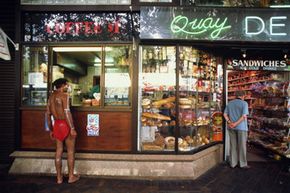Aboriginal Australians Today
The 2016 census in Australia showed that the 649,171 people identified themselves as being "of Aboriginal or Torres Strait Islander origin," up 18.4 percent from 2011. This represented 3.3 percent of the Australian population, up from 3 percent in 2011. The rapid increase may be due to the fact that Aboriginal Australians have slightly larger families than non-Aboriginal Australians and also that more people may be identifying in this group, particularly those from mixed unions [source: Biddle and Markham].
Also, the number of people speaking an Australian indigenous language at home increased slightly, to 63,754 people from 60,550 in 2011. And the percentage attending high school increased to nearly 60 percent from 51 percent in 2011. Household income had also increased, although it was still only two-thirds of what a non-indigenous Australian would earn [source: Biddle and Markham]. So, although things are improving, there are still glaring inequalities between the races.
Advertisement
Rates of alcoholism are much higher among Aboriginal Australians than other Australians, even though they are less likely to drink alcohol. One study found that 14.8 percent of indigenous men in remote areas consumed alcohol at hazardous levels versus 10.4 percent in non-remote areas. About 30 percent of indigenous Australians live below the poverty line, according to the Australian government, versus 13.6 percent of the population generally. A startling 70 percent of young indigenous Australians (20-24 years) were engaged in neither work nor education.
Many traditional Australians are trying to spread their history to the members of their community who seem to have lost it. They've hired teachers to train students in the traditional Aboriginal languages. Even a few radio and TV stations feature only Aboriginal programming to educate the generations that have had no prior experience with their culture.
And of course, there's Aboriginal art. Their art is world-famous, and many Aboriginal Australians make a living off selling their pieces. Traditionally, they view art much like their dreamings: sacred and secret. Only a select few people, after reaching a proper level of knowledge of Aboriginal history, are permitted to see the artwork. In recent years, though, that's changed, so some artists can make money to support themselves and their families.
Aboriginal art comes in many media: paintings, beadwork, woodwork, bark paintings and baskets. Aboriginal Australians also make and sell the most famous item to come out of Australia: the boomerang. But some art can't be sold – it's on the walls of caves. A famous Australian landmark, Ayers Rock, is one such place. It's an Aboriginal sacred site named Uluru, located near the center of Australia. The rock covers a series of caves. Within those caves are walls and walls of paintings done by Aboriginal Australians to illustrate their dreamings. While people visit Ayers Rock and see the paintings, there's still no way to know what they mean. And the Aboriginal people, for the time being, are keeping it a secret. The rock was closed to tourists in 2019, because of its sacred nature to Aboriginal Australians.
Related Articles
More Great Links
Sources
- Agence France-Presse. "Australian Court Rule That the City of Perth Belongs to Aboriginal people." The New York Times. September 21, 2006.http://www.nytimes.com/2006/09/21/world/asia/21australia.html?_r=1&oref=slogin.
- Agence France-Presse. "Australia; $450,000 For 'Stolen' Aborigine." The New York Times. August 2, 2007.
- Australian Bureau of Statistics. Aboriginal and Torres Strait Islander Population.http://www.abs.gov.au/AUSSTATS/abs@.nsf/featurearticlesbytitle/06E6409495FF5247CA256DEA00053A04?OpenDocument.
- Australian Government - Culture and Recreation Portal. "Australian Indigenous Cultural Heritage."http://www.cultureandrecreation.gov.au/articles/indigenous/.
- Australian Human Rights and Equal Opportunity Commission. The Report on the National Inquiry into the Separation of Aboriginal and Torrest Strait Islander Children From their Families.http://www.hreoc.gov.au/pdf/social_justice/submissions_un_hr_committee/6_stolen_generations.pdf
- BBC News. "Australia Apology to Aboriginal people."http://news.bbc.co.uk/2/hi/asia-pacific/7216873.stm
- Biddle and Markham. "Census 2016: What's Changed for Indigenous Australians?" The Conversation. June 27,2017 (Jan. 17, 2020) https://theconversation.com/census-2016-whats-changed-for-indigenous-australians-79836
- Bond, John. "Return to Cootamundra: Healing? For Me That's Impossible, Val Linow Told John Bond." For a Change. December 2005.http://www.forachange.co.uk/browse/2084.html.
- Dalmau, Tim. "Aboriginal Wisdom, Aboriginal Rights - Australian Aboriginal people." Whole Earth Review. Spring, 1992.http://findarticles.com/p/articles/mi_m1510/is_n74/ai_11891472/print.
- Jacobs, Christine. "I Don't Want Your Pity, Just Listen." For a Change. August-September 2005.http://www.forachange.co.uk/browse/2060.html.
- Jet Magazine. "Australian Parliament Expresses Regret for Injustice to Aboriginal people." Sept. 13, 1999.http://findarticles.com/p/articles/mi_m1355/is_15_96/ai_55983440/print.
- Marks, Kathy. "Aboriginal people Mark the Day They Became 'Humans.'" The Independent. May 26, 2007.http://news.independent.co.uk/world/australasia/article2584125.ece.
- Marks, Kathy. "Cries of Racism Over Plan to Cut Child Abuse in Aboriginal people." The Independent. June 29, 2007.http://news.independent.co.uk/world/australasia/article2720109.ece
- Marks, Kathy. "'Stolen Generation' Aborigine Wins Test Case." The Independent.http://news.independent.co.uk/world/australasia/article2831091.ece.
- Oppenheimer, Stephen. " Out of Africa." The Independent. July 9, 2003.http://news.independent.co.uk/sci_tech/article95400.ece.
- Parliament of Australia. "The Stolen Generation."http://www.aph.gov.au/library/intguide/SP/Stolen.htm.
- Ravilious, Kate. "Aboriginal people, Europeans Share African Roots, DNA Suggests." National Geographic News. May 7, 2007.http://news.nationalgeographic.com/news/pf/97179615.
- Ross, Kate and Taylor, John. "Improving Life Expectancy and Health Status: A Comparison of Indigenous Australians and New Zealand Maori." Journal of Population Research. September 2002.http://www.jpr.org.au/upload/Special2002pp219-238.pdf.
- Suter, Keith. "Australia - One Land: Two Peoples." Contemporary Review. August, 2003.http://findarticles.com/p/articles/mi_m2242/is_1651_283/ai_107897407/print.
- Wade, Nicholas. "From DNA Analysis, Clues to a Single Australian Migration." The New York Times. May 8, 2007.http://www.nytimes.com/2007/05/08/science/08abor.html?scp=1&sq=Australian+Migration.
- Zielinska, Edyta. "Walkabout." Natural History. Sept. 2006.http://findarticles.com/p/articles/mi_m1134/is_7_115/ai_n16713949.
